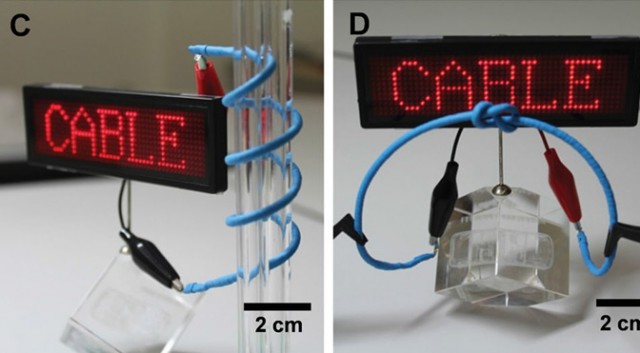LG has invented a battery in the form of a bending wire
LG Chem, a member of the LG group of companies and one of the largest chemical companies in the world, invented a lithium-ion battery in the form of a cable several millimeters in diameter and plastic enough to be tied into a knot, worn as a bracelet or embedded in fabric.
The chemical process that takes place in such a cable is the same as in any other lithium-ion battery of a smartphone or laptop: the anode, the cathode of lithium-cobalt oxide, the electrolyte - but instead of being arranged in layers, they are twisted into hollow, bent wires .
')

The battery, invented by LG Chem's, is made as follows. The threads of copper wire coated with an alloy of nickel and tin, creating an anode, are woven into a thicker thread, and then wrapped around a 1.5-mm rod. Then the rod is removed, leaving a strong thread. After that, aluminum wire is wound around the filament, and then the entire structure is placed in a suspension of lithium oxide and cobalt, which covers the aluminum wire and becomes the cathode. In the end, the cathode anode is wrapped with insulation and the hollow space of the filament is filled with electrolyte, thus creating a battery.
Of course, the bent batteries were created before, but they were only ordinary, flat batteries, made not of the most optimal materials, such as polymers. As a result, they had a small capacity, and the flexibility was limited by the flexibility of the plastic sheet (see video). The battery assembled in the LG Chem has the same voltage and capacity as a regular smartphone battery, but it is thin and well bendable. The 25 cm battery feeds the iPod Shuffle for 10 hours. LG aims to launch mass production of such batteries by 2017.
For your information, batteries are the only significant limitation to the widespread distribution of high-powered computers. While Intel is committed to producing transistors of sizes with several atoms and processors performing billions of operations per second, consuming only a few watts, we are still stuck with clunky batteries having only a few form factors.
If batteries are removed from the equation, new form factors will blow up the market. Instead of cylindrical batteries in laptops or
parallelepipeds in smartphones and tablets, batteries in the form of wires will allow to apply them everywhere - on the edge of the chassis, around the perimeter of the screen. Instead of creating devices with a built-in battery, you can wear the battery around your neck or waist, or embed it in clothing. Smartphones and tablets will lose half the weight, and devices will become flexible and roll up diploma will become a reality.
The chemical process that takes place in such a cable is the same as in any other lithium-ion battery of a smartphone or laptop: the anode, the cathode of lithium-cobalt oxide, the electrolyte - but instead of being arranged in layers, they are twisted into hollow, bent wires .
')

The battery, invented by LG Chem's, is made as follows. The threads of copper wire coated with an alloy of nickel and tin, creating an anode, are woven into a thicker thread, and then wrapped around a 1.5-mm rod. Then the rod is removed, leaving a strong thread. After that, aluminum wire is wound around the filament, and then the entire structure is placed in a suspension of lithium oxide and cobalt, which covers the aluminum wire and becomes the cathode. In the end, the cathode anode is wrapped with insulation and the hollow space of the filament is filled with electrolyte, thus creating a battery.
Of course, the bent batteries were created before, but they were only ordinary, flat batteries, made not of the most optimal materials, such as polymers. As a result, they had a small capacity, and the flexibility was limited by the flexibility of the plastic sheet (see video). The battery assembled in the LG Chem has the same voltage and capacity as a regular smartphone battery, but it is thin and well bendable. The 25 cm battery feeds the iPod Shuffle for 10 hours. LG aims to launch mass production of such batteries by 2017.
For your information, batteries are the only significant limitation to the widespread distribution of high-powered computers. While Intel is committed to producing transistors of sizes with several atoms and processors performing billions of operations per second, consuming only a few watts, we are still stuck with clunky batteries having only a few form factors.
If batteries are removed from the equation, new form factors will blow up the market. Instead of cylindrical batteries in laptops or
parallelepipeds in smartphones and tablets, batteries in the form of wires will allow to apply them everywhere - on the edge of the chassis, around the perimeter of the screen. Instead of creating devices with a built-in battery, you can wear the battery around your neck or waist, or embed it in clothing. Smartphones and tablets will lose half the weight, and devices will become flexible and roll up diploma will become a reality.
Source: https://habr.com/ru/post/150579/
All Articles